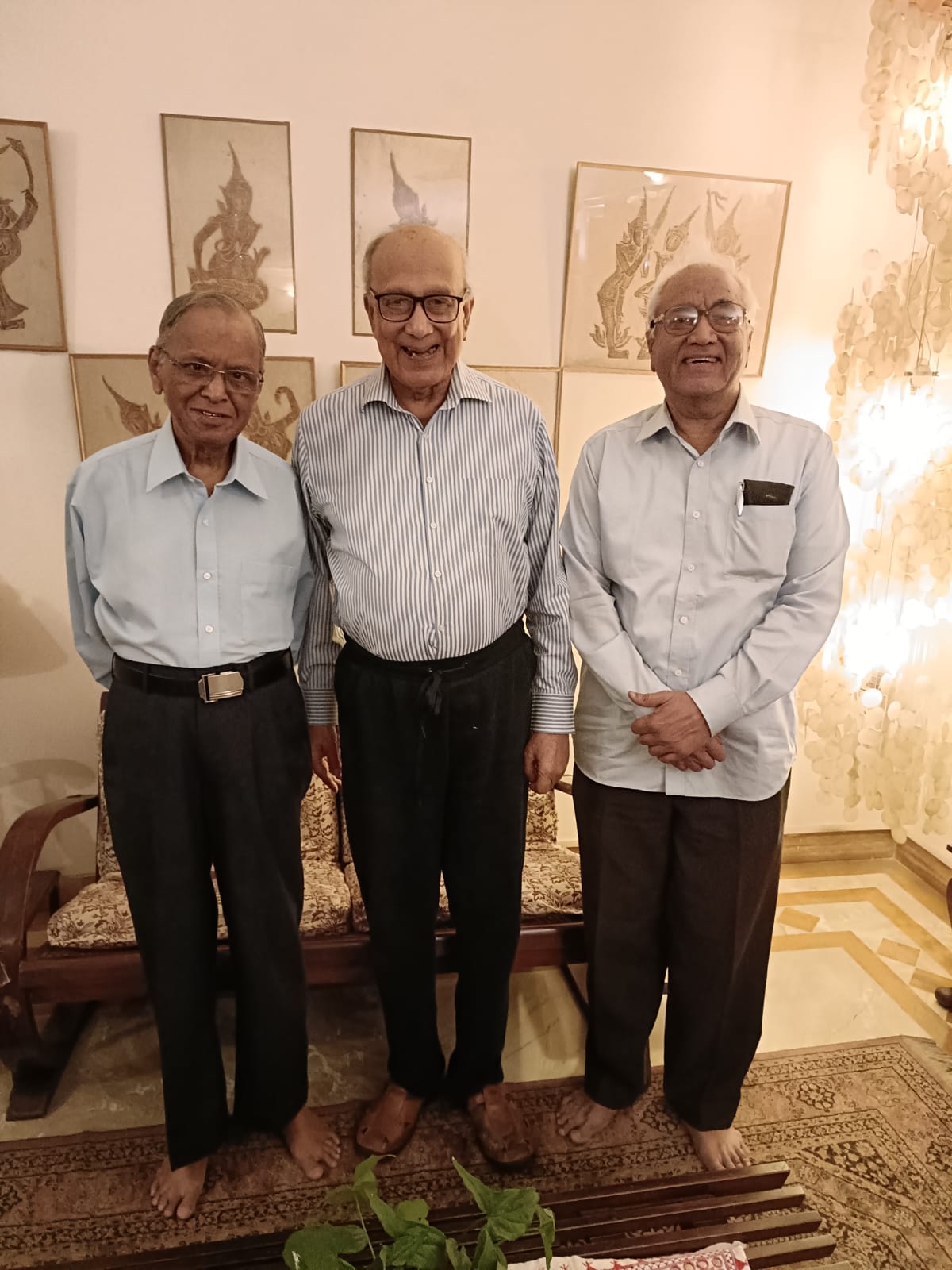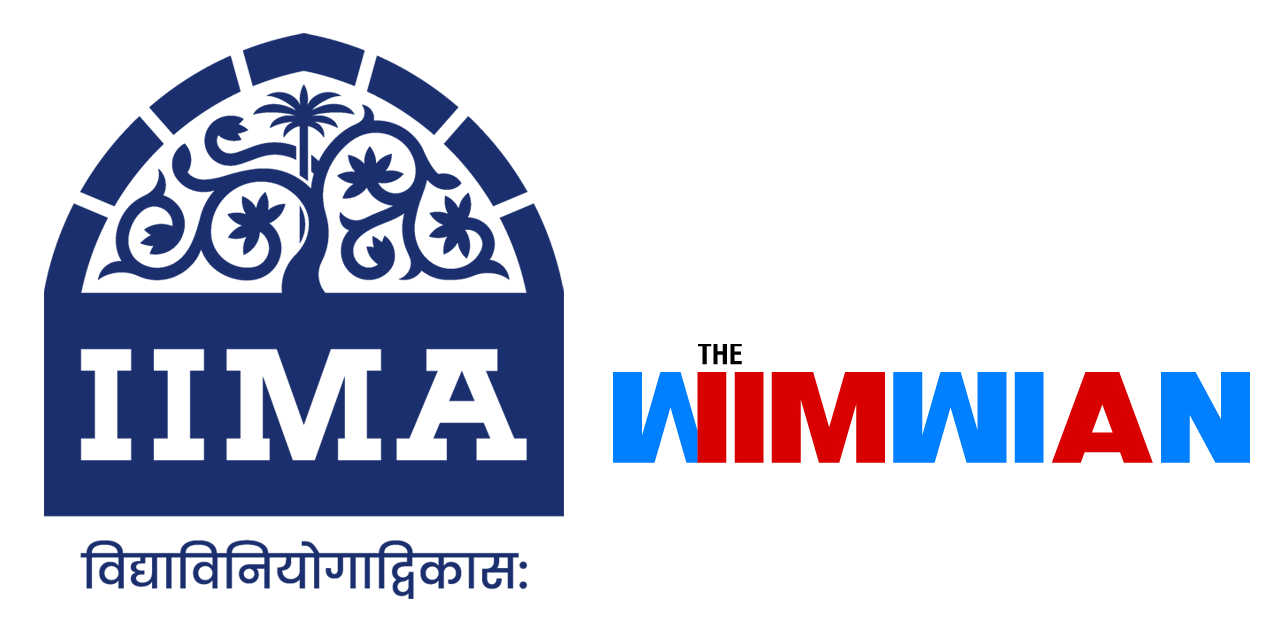Making a difference: How System Research Institute applied management principles to Public Systems
By Shashi Kant Sharma, PGP 73

From left to right: N R Narayan Murthy, Prof J G Krishnayya and Shashi Kant Sharma
(Disclaimer: What I am narrating, pertains to a period more than 40 years ago. So, there may be errors relating to dates, chronology, names, events etc. For those, my apologies in advance.)
Systems Research Institute was the brainchild of Prof J G Krishnayya (widely known as JGK).
JGK was a faculty member in the Quantitative Methods area at IIMA. He was a graduate of MIT, USA and had also participated in the ITP at the Harvard Business School.
Apart from his usual academic responsibilities, JGK was head of the computer centre at IIMA. He was a visionary in the field of technology – and imported the first computer in India which had a disc-based operating system, and which was a multi-user system which could be simultaneously used by 18 users.
By the mid-1970s, the MBA programme had established itself as a credible and rewarding academic domain. Graduates of the IIMs and other institutes of management had made a mark in the corporate sector and had proven their worth. That was a very authentic validation of the contents and processes incorporated in the MBA (erstwhile PGP) curriculum.
JGK observed that though the MBA degree and brand had been well accepted in the corporate world, no effort had been made to apply the same professional management techniques and concepts in the Public Systems in India, particularly the Government sector and that is where the idea of Systems Research Institute emerged– to create an organisation which would focus on improving effectiveness and efficiencies in the Public Systems domain using professional Management field as a source of ideas, design, and action.
I joined the two-year PGP in 1971. JGK used to teach us MSM – I; and he started with a bang: giving a quiz in the very first session!In the second year, I signed up for several electives with him – MIS, Seminar on Cybernetics, etc.
In the second year, second term he invited me to his office, outlined the idea of SRI and offered me a job there and then. I accepted for several reasons – I had decided not to take up any job in Bombay (now Mumbai) and SRI was to be set up in Poona (now Pune); the salary offered was the holy grail of those days “four figures”; and “Known devil is better than the unknown devil,” and many such reasons.
When SRI convened in Poona in June 1974, on the very first day there were 3 people in the team – JGK, myself and Shri N.R. Narayan Murthy (of Infosys’ fame, how NRN – as he is popularly known – arrived there is another story).
I stayed with SRI from then to 1982 (except for a period of study leave when I went to do another masters at MIT, USA).
We did some very interesting and, hopefully, impactful studies for Ministries of Petroleum, Agriculture, Tribal Welfare, and other public systems like Hospitals, Educational institutions, etc.
It would not be feasible to cover the stories related to all those projects so let me try to share only two (that too briefly).
What should the Ministry of Petroleum do and why?
The mandate for ONGC was to drill for petroleum and help towards energy security of the nation. ONGC struck oil in Gujarat in 1958 and Assam in 1963 and their growth journey continues.
Another company was set up in 1959 in the field of oil exploration – that was Oil India Limited (OIL) with a partnership between the British-owned Burmah Oil Company and the Government of India.
At some stage, the Ministry of Petroleum was seized with the question of whether ONGC and OIL should be merged – and SRI was asked to conduct a study and suggest an answer. This would have been somewhere around 1975.
JGK, NRN, and I formed the core team for the study. NRN and I spent more than a month in Assam conducting a comprehensive data collection drive in both organisations. (At that time OIL had no operations outside Assam.)
Some interesting metrics were developed for comparison – for example, “Bit on Bottom Hours” as a measure of productivity.
We compared the technologies used by the respective organizations – for example, ONGC was using Russian rigs and OIL had A-frame American rigs. The latter were more “agile” so the rig could be shifted from one location to another relatively quickly.
We compared the cultures of the two organizations including the leadership – ONGC was headed by a geologist whereas OIL had a military officer of the rank of General at the top.
We compared the HRM strategies, the Finances, the approach to Operations and so on.
To conclude, we submitted a report to the Ministry of Petroleum recommending that the two organizations should be kept separate – the primary logic being that the average efficiency of the 2 organizations will be more than that of any merged entity!
The final decision was not ours but we can take some credit that even today ONGC and OIL remain two independent entities.
The Kandla Port Conundrum
As a consequence of the partition of the country in 1947, we lost Karachi port to Pakistan.
Almost as a knee-jerk reaction (as said by a Ministry of Shipping official in an informal conversation), the government decided to set up Kandla port on the West Coast. Right from the beginning, it had several handicaps:
- There was a constant need for dredging.
- Most of the cargo traffic was inbound and as a result, railways had to haul empty wagons to the port.
- There was very poor infrastructure – for example, among the 3 significant geographic nodes of Kandla, Gandhidham, and Adipur the telephonic link was through trunk calls (you had to ask the exchange operator to place a call and then wait till you were connected).
- There were hardly any hotel rooms which could be used by customs clearing agents, clearing and forwarding agents.
SRI was invited by the Planning Commission to conduct a comprehensive systems study and suggest remedial measures.
I spent more than a month in Kandla (staying at the IFFCO guest house) studying the situation, collecting data, interviewing a slew of stakeholders and then, after due digesting of all inputs, submitted our recommendations
- Need to improve and modernise the infrastructure, particularly in the telecom and hospitality sectors
- Need to set up an export processing zone where outward cargo can be generated and the railways would have items to bring into Kandla as inputs to the export processing activities.
- Convert the rail track from Metre gauge to Broad gauge.
- Create a massive container terminal to take advantage of the fact that Kandla has very low rainfall and large tracts of flat lands are available at fairly low cost.
SRI closed down three years ago but it was part of many important projects like designing a monitoring system for agricultural projects, network configuration of computers to support steel distribution in India, demand forecasting for petroleum products using a Bayesian Model, assessment of computerisation needs of Air India and Indian Airlines when both were government undertakings, and organisational evaluation of Christian Medical College and Hospital (CMCH), Vellore among others.
I sincerely believe that SRI made a difference and has proven that there is a need and a place for objective, non-partisan, and competent think-tanks who can take a long-term perspective on our nation’s development.

